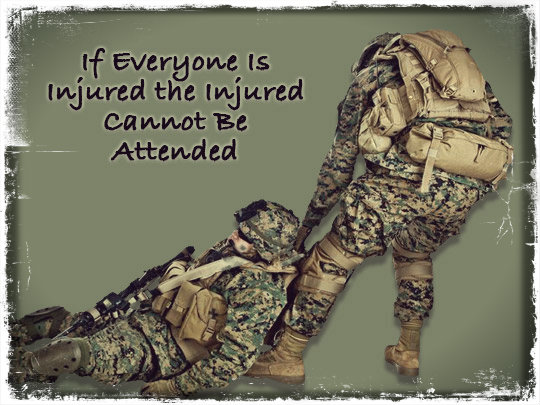

| Online: | |
| Visits: | |
| Stories: |
If Everyone Is Injured the Injured Cannot Be Attended

Some of you may have experienced squad or platoon leaders reminding you to maintain distance. Don’t bunch up as you head out past the wire into the badlands. Maintain at least 5 yards or 15 feet. One of the reasons for maintaining distance is if someone steps on an anti-personal mine, for example, soldiers next to them are not injured as well. The same would apply if a hand grenade was launched, or if the team walks into an ambush.
Sometimes the only thing a soldier had to hang on to was the fact that if they were injured others would Evac them to a Landing Zone (LZ) for evacuation to the rear for treatment. Dust Off, (Dedicated Unhesitating Service to Our Fighting Forces), was the call sign for Air Ambulance Units, which usually transported the injured. If all team members are injured, who then would tend to the injured, and see to it they were loaded up and sent back to a field hospital. Distance is important when patrolling.
Once the SHTF you may very well have to patrol in unfamiliar terrain and so you need a plan, and you need to know some basics about patrolling when past the wire, so to speak.
Know Where You Are Going Even If Your Don’t Know Where You Are Going
Walk with a purpose and map your routes using a topographical map and compass. The point person usually navigates for the team, so whoever is on point must be well versed in land navigation using a map and compass.
You are in an unfamiliar area so break it down and patrol a certain sector. You are gathering Intel, so note natural and man-made resources for future use. You want to determine who else might be in the area, as well, friend, or foes to be determined later, so stealth is important until you know. You cannot wander willy-nilly and someone has to set the pace and the routes used.
It is not a democracy, you can’t stop every five minutes to discuss tactics and have everyone voicing their opinions. Leaders lead and make the decisions. You do want feedback, but not arguments about destination and purpose of the patrol while on patrol. Typically, actions are analyzed in After Action Reports. This is when mistakes and various tactics are discussed and adaptations to plans are made.
Patrol for a few hundred yards in heavy brush and then stop to listen and observe. Certain team members can walk the flank 50 to one 100 yards out depending on the terrain and one or two can hang back to cover the back trail.
Your team will need a communications expert, and in the old days, a radio strapped to the back was akin to waving a red flag in front of a bull. The AN/PRC’s (Army/Navy Portable Radio Communications) of the day made for a heavy pack and they had long antennas. Snipers would target the Comms guy. The radio person was glued to the platoon leader and the radio was the only contact with the world. Air strikes/air support, Dust Off, and supply requests all went through the radio guy, along with Intel on enemy size and movement.
In your group, however, it is likely everyone would have a personal communication device, but you have to maintain communications discipline. You can’t have team members talking it up with each other whenever they feel like it. For one thing, you don’t know who may be monitoring radio or other communication streams and maybe trying to triangulate your location. The more people talk the greater chance of revealing sensitive information about locations, and number of personnel and how well armed and supplied your group or team may be.
Set a time that each person checks in with a designated Comms person, and use call signs or nicknames and not real names.
Medical
Back to the title of this article don’t bunch up. If there is a sniper and everyone is huddled around a fire or standing around shooting the breeze a good shooter can put 3 or 4 down before you realize you are under attack. If targets are separated the shooter has to adjust, even though it is just a split second, it still gives others time to react. The first shot, which means there is a first casualty gives the others time to seek cover and then provide cover fire so the injured can be moved out of the line of fire. The injured needs to know others are alive and able to render aid.
Your team members all need to know the basics of first aid, and then one or two should have more advanced training in first aid.
You are not necessarily a fire team, but you may come under fire, but your objective in most cases is to gather Intel, and avoid contact with others. You want to map out escape routes, supply routes and track movement of others and perhaps track a group back to their compound all without being detected.
The above is simply the basics. It takes time for a team to be able to work as a cohesive unit. You need to know the weaknesses and strengths of all members, and you will over time. During downtime cross train, have your medic teach classes as well as your Comms person or electronics expert and always do weapons training. Downtime is the time to air grievances and to discuss personal issues, and not when out patrolling.
The post If Everyone Is Injured the Injured Cannot Be Attended appeared first on Preparing for shtf.
Source: prepforshtf.com
Source: http://prepforshtf.com/if-everyone-is-injured-the-injured-cannot-be-attended/



